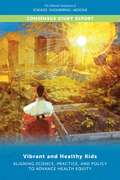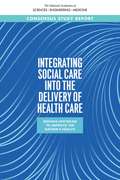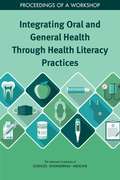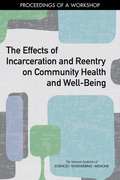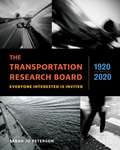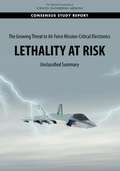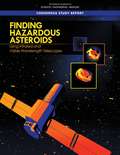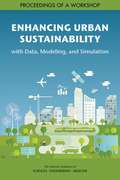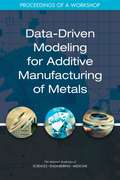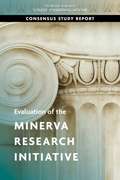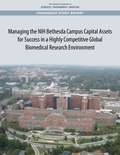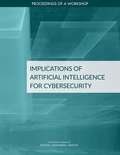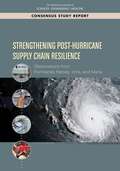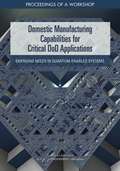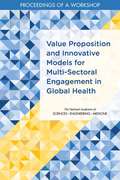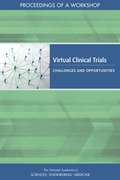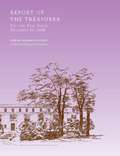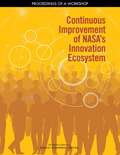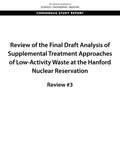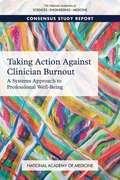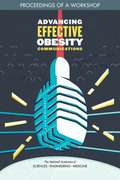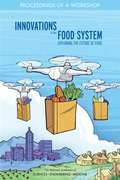- Table View
- List View
Vibrant and Healthy Kids: Aligning Science, Practice, And Policy To Advance Health Equity
by National Academies of Sciences Engineering MedicineChildren are the foundation of the United States, and supporting them is a key component of building a successful future. However, millions of children face health inequities that compromise their development, well-being, and long-term outcomes, despite substantial scientific evidence about how those adversities contribute to poor health. Advancements in neurobiological and socio-behavioral science show that critical biological systems develop in the prenatal through early childhood periods, and neurobiological development is extremely responsive to environmental influences during these stages. Consequently, social, economic, cultural, and environmental factors significantly affect a child’s health ecosystem and ability to thrive throughout adulthood. Vibrant and Healthy Kids: Aligning Science, Practice, and Policy to Advance Health Equity builds upon and updates research from Communities in Action: Pathways to Health Equity (2017) and From Neurons to Neighborhoods: The Science of Early Childhood Development (2000). This report provides a brief overview of stressors that affect childhood development and health, a framework for applying current brain and development science to the real world, a roadmap for implementing tailored interventions, and recommendations about improving systems to better align with our understanding of the significant impact of health equity.
Integrating Social Care into the Delivery of Health Care: Moving Upstream To Improve The Nation's Health
by National Academies of Sciences Engineering MedicineThe consistent and compelling evidence on how social determinants shape health has led to a growing recognition throughout the health care sector that improving health and health equity is likely to depend – at least in part – on mitigating adverse social determinants. This recognition has been bolstered by a shift in the health care sector towards value-based payment, which incentivizes improved health outcomes for persons and populations rather than service delivery alone. The combined result of these changes has been a growing emphasis on health care systems addressing patients’ social risk factors and social needs with the aim of improving health outcomes. This may involve health care systems linking individual patients with government and community social services, but important questions need to be answered about when and how health care systems should integrate social care into their practices and what kinds of infrastructure are required to facilitate such activities. Integrating Social Care into the Delivery of Health Care: Moving Upstream to Improve the Nation’s Health examines the potential for integrating services addressing social needs and the social determinants of health into the delivery of health care to achieve better health outcomes. This report assesses approaches to social care integration currently being taken by health care providers and systems, and new or emerging approaches and opportunities; current roles in such integration by different disciplines and organizations, and new or emerging roles and types of providers; and current and emerging efforts to design health care systems to improve the nation’s health and reduce health inequities.
Integrating Oral and General Health Through Health Literacy Practices: Proceedings Of A Workshop
by National Academies of Sciences Engineering MedicineOral health care and medical health care both seek to maintain and enhance human health and well-being. Yet, dentistry and primary care in the United States are largely separated and isolated from each other. Each has its own siloed systems for education, service delivery, financing, and policy oversight. The result has been duplication of effort, a cultural gap between the two professions, and lost opportunities for productive collaboration and better health. On December 6, 2018, in Washington, DC, the National Academies of Sciences, Engineering, and Medicine held a workshop titled Integrating Oral and General Health Through Health Literacy Practices. This publication summarizes the presentations and discussions from the workshop.
The Effects of Incarceration and Reentry on Community Health and Well-Being: Proceedings Of A Workshop
by National Academies of Sciences Engineering MedicineThe high rate of incarceration in the United States contributes significantly to the nation’s health inequities, extending beyond those who are imprisoned to families, communities, and the entire society. Since the 1970s, there has been a seven-fold increase in incarceration. This increase and the effects of the post-incarceration reentry disproportionately affect low-income families and communities of color. It is critical to examine the criminal justice system through a new lens and explore opportunities for meaningful improvements that will promote health equity in the United States. The National Academies convened a workshop on June 6, 2018 to investigate the connection between incarceration and health inequities to better understand the distributive impact of incarceration on low-income families and communities of color. Topics of discussion focused on the experience of incarceration and reentry, mass incarceration as a public health issue, women’s health in jails and prisons, the effects of reentry on the individual and the community, and promising practices and models for reentry. The programs and models that are described in this publication are all Philadelphia-based because Philadelphia has one of the highest rates of incarceration of any major American city. This publication summarizes the presentations and discussions of the workshop.
The Transportation Research Board, 1920–2020: Everyone Interested Is Invited
by Sarah PetersonIn The Transportation Research Board, 1920–2020: Everyone Interested Is Invited, author Sarah Jo Peterson tells the story of how people and institutions created and have continued to shape TRB. In a compelling narrative accompanied by more than 150 images exploring the history of transportation and research, she argues that TRB can be best understood as an infrastructure—one that people purposely designed and devotedly maintained.
Management of Legionella in Water Systems
by National Academies of Sciences Engineering MedicineLegionnaires’ disease, a pneumonia caused by the Legionella bacterium, is the leading cause of reported waterborne disease outbreaks in the United States. Legionella occur naturally in water from many different environmental sources, but grow rapidly in the warm, stagnant conditions that can be found in engineered water systems such as cooling towers, building plumbing, and hot tubs. Humans are primarily exposed to Legionella through inhalation of contaminated aerosols into the respiratory system. Legionnaires’ disease can be fatal, with between 3 and 33 percent of Legionella infections leading to death, and studies show the incidence of Legionnaires’ disease in the United States increased five-fold from 2000 to 2017. Management of Legionella in Water Systems reviews the state of science on Legionella contamination of water systems, specifically the ecology and diagnosis. This report explores the process of transmission via water systems, quantification, prevention and control, and policy and training issues that affect the incidence of Legionnaires’ disease. It also analyzes existing knowledge gaps and recommends research priorities moving forward.
The Growing Threat to Air Force Mission-Critical Electronics: Lethality At Risk: Unclassified Summary
by National Academies of Sciences Engineering MedicineHigh-performance electronics are key to the U.S. Air Force’s (USAF’s) ability to deliver lethal effects at the time and location of their choosing. Additionally, these electronic systems must be able to withstand not only the rigors of the battlefield but be able to perform the needed mission while under cyber and electronic warfare (EW) attack. This requires a high degree of assurance that they are both physically reliable and resistant to adversary actions throughout their life cycle from design to sustainment. In 2016, the National Academies of Sciences, Engineering, and Medicine convened a workshop titled Optimizing the Air Force Acquisition Strategy of Secure and Reliable Electronic Components, and released a summary of the workshop. This publication serves as a follow-on to provide recommendations to the USAF acquisition community.
Finding Hazardous Asteroids Using Infrared and Visible Wavelength Telescopes
by National Academies of Sciences Engineering MedicineNear Earth objects (NEOs) have the potential to cause significant damage on Earth. In December 2018, an asteroid exploded in the upper atmosphere over the Bering Sea (western Pacific Ocean) with the explosive force of nearly 10 times that of the Hiroshima bomb. While the frequency of NEO impacts rises in inverse proportion to their sizes, it is still critical to monitor NEO activity in order to prepare defenses for these rare but dangerous threats. Currently, NASA funds a network of ground-based telescopes and a single, soon-to-expire space-based asset to detect and track large asteroids that could cause major damage if they struck Earth. This asset is crucial to NEO tracking as thermal-infrared detection and tracking of asteroids can only be accomplished on a space-based platform. Finding Hazardous Asteroids Using Infrared and Visible Wavelength Telescopes explores the advantages and disadvantages of infrared (IR) technology and visible wavelength observations of NEOs. This report reviews the techniques that could be used to obtain NEO sizes from an infrared spectrum and delineate the associated errors in determining the size. It also evaluates the strengths and weaknesses of these techniques and recommends the most valid techniques that give reproducible results with quantifiable errors.
Understanding the Aging Workforce: Defining A Research Agenda
by National Academies of Sciences, Engineering, and Medicine Division of Behavioral and Social Sciences and Education Committee on National Statistics Committee on Population Committee on Understanding the Aging Workforce and Employment at Older AgesThe aging population of the United States has significant implications for the workforce - challenging what it means to work and to retire in the U.S. In fact, by 2030, one-fifth of the population will be over age 65. This shift has significant repercussions for the economy and key social programs. Due to medical advancements and public health improvements, recent cohorts of older adults have experienced better health and increasing longevity compared to earlier cohorts. These improvements in health enable many older adults to extend their working lives. While higher labor market participation from this older workforce could soften the potential negative impacts of the aging population over the long term on economic growth and the funding of Social Security and other social programs, these trends have also occurred amidst a complicating backdrop of widening economic and social inequality that has meant that the gains in health, improvements in mortality, and access to later-life employment have been distributed unequally. Understanding the Aging Workforce: Defining a Research Agenda offers a multidisciplinary framework for conceptualizing pathways between work and nonwork at older ages. This report outlines a research agenda that highlights the need for a better understanding of the relationship between employers and older employees; how work and resource inequalities in later adulthood shape opportunities in later life; and the interface between work, health, and caregiving. The research agenda also identifies the need for research that addresses the role of workplaces in shaping work at older ages, including the role of workplace policies and practices and age discrimination in enabling or discouraging older workers to continue working or retire.
Enhancing Urban Sustainability with Data, Modeling, and Simulation: Proceedings Of A Workshop
by National Academies of Sciences Engineering MedicineOn January 30-31, 2019 the Board on Mathematical Sciences and Analytics, in collaboration with the Board on Energy and Environmental Systems and the Computer Science and Telecommunications Board, convened a workshop in Washington, D.C. to explore the frontiers of mathematics and data science needs for sustainable urban communities. The workshop strengthened the emerging interdisciplinary network of practitioners, business leaders, government officials, nonprofit stakeholders, academics, and policy makers using data, modeling, and simulation for urban and community sustainability, and addressed common challenges that the community faces. Presentations highlighted urban sustainability research efforts and programs under way, including research into air quality, water management, waste disposal, and social equity and discussed promising urban sustainability research questions that improved use of big data, modeling, and simulation can help address. This publication summarizes the presentation and discussion of the workshop.
Data-Driven Modeling for Additive Manufacturing of Metals: Proceedings of a Workshop
by National Academies of Sciences Engineering MedicineAdditive manufacturing (AM) is the process in which a three-dimensional object is built by adding subsequent layers of materials. AM enables novel material compositions and shapes, often without the need for specialized tooling. This technology has the potential to revolutionize how mechanical parts are created, tested, and certified. However, successful real-time AM design requires the integration of complex systems and often necessitates expertise across domains. Simulation-based design approaches, such as those applied in engineering product design and material design, have the potential to improve AM predictive modeling capabilities, particularly when combined with existing knowledge of the underlying mechanics. These predictive models have the potential to reduce the cost of and time for concept-to-final-product development and can be used to supplement experimental tests. The National Academies convened a workshop on October 24-26, 2018 to discuss the frontiers of mechanistic data-driven modeling for AM of metals. Topics of discussion included measuring and modeling process monitoring and control, developing models to represent microstructure evolution, alloy design, and part suitability, modeling phases of process and machine design, and accelerating product and process qualification and certification. These topics then led to the assessment of short-, immediate-, and long-term challenges in AM. This publication summarizes the presentations and discussions from the workshop.
Evaluation of the Minerva Research Initiative
by National Academies of Sciences Engineering MedicineThe Minerva Research Initiative is a Department of Defense (DoD) social science grant program that funds unclassified basic research relevant to national security. The goal of the program is to make use of the intellectual capital of university-based social scientists to inform understanding of issues important to DoD and the broader national security community. Evaluation of the Minerva Research Initiative discusses the program's successes and challenges over its first decade of operation, and highlights ways to strengthen the program’s foundations and take advantage of opportunities for broadening its reach and usefulness.
Managing the NIH Bethesda Campus Capital Assets for Success in a Highly Competitive Global Biomedical Research Environment
by Engineering Medicine National Academies of SciencesThe National Institutes of Health (NIH) is the primary agency of the United States government responsible for biomedical and public health research. Founded in the late 1870s, NIH has produced extraordinary advances in the treatment of common and rare diseases and leads the world in biomedical research. It is a critical national resource that plays an important role in supporting national security. The 310-acre Bethesda campus supports some 20,000 employees and contractors, and it contains more than 12 million square feet of facilities divided amongst nearly 100 buildings, including the largest dedicated research hospital in the world. The Bethesda campus supports some of the most sophisticated and groundbreaking biomedical research in the world. However, while some new state-of-the-art buildings have been constructed in recent years, essential maintenance for many facilities and the campus overall has been consistently deferred for many years. The deteriorating condition of NIH’s built environment is now putting its ability to fulfill its mission at substantial risk. Managing the NIH Bethesda Campus’s Capital Assets for Success in a Highly Competitive Global Biomedical Research Environment identifies the facilities in greatest need of repair on the Bethesda campus and evaluates cost estimates to determine what investment is needed for the NIH to successfully accomplish its mission going forward.
Implications of Artificial Intelligence for Cybersecurity: Proceedings Of A Workshop
by National Academies of Sciences Engineering MedicineIn recent years, interest and progress in the area of artificial intelligence (AI) and machine learning (ML) have boomed, with new applications vigorously pursued across many sectors. At the same time, the computing and communications technologies on which we have come to rely present serious security concerns: cyberattacks have escalated in number, frequency, and impact, drawing increased attention to the vulnerabilities of cyber systems and the need to increase their security. In the face of this changing landscape, there is significant concern and interest among policymakers, security practitioners, technologists, researchers, and the public about the potential implications of AI and ML for cybersecurity. The National Academies of Sciences, Engineering, and Medicine convened a workshop on March 12-13, 2019 to discuss and explore these concerns. This publication summarizes the presentations and discussions from the workshop.
Strengthening Post-Hurricane Supply Chain Resilience: Observations From Hurricanes Harvey, Irma, And Maria
by National Academies of Sciences Engineering MedicineResilient supply chains are crucial to maintaining the consistent delivery of goods and services to the American people. The modern economy has made supply chains more interconnected than ever, while also expanding both their range and fragility. In the third quarter of 2017, Hurricanes Harvey, Irma and Maria revealed some significant vulnerabilities in the national and regional supply chains of Texas, Florida, the U.S. Virgin Islands, and Puerto Rico. The broad impacts and quick succession of these three hurricanes also shed light on the effectiveness of the nation's disaster logistics efforts during response through recovery. Drawing on lessons learned during the 2017 hurricanes, this report explores future strategies to improve supply chain management in disaster situations. This report makes recommendations to strengthen the roles of continuity planning, partnerships between civic leaders with small businesses, and infrastructure investment to ensure that essential supply chains will remain operational in the next major disaster. Focusing on the supply chains food, fuel, water, pharmaceutical, and medical supplies, the recommendations of this report will assist the Federal Emergency Management Agency as well as state and local officials, private sector decision makers, civic leaders, and others who can help ensure that supply chains remain robust and resilient in the face of natural disasters.
Domestic Manufacturing Capabilities for Critical DoD Applications: Emerging Needs In Quantum-enabled Systems: Proceedings Of A Workshop
by Engineering Medicine National Academies of SciencesRecent advancements in quantum-enabled systems present a variety of new opportunities and challenges. These technologies are important developments for a variety of computing, communications, and sensing applications. However, many materials and components relevant to quantum-enabled systems exist outside of the United States, and it is important to promote the development of assured domestic sources of materials, manufacturing capabilities, and expertise. The National Academies of Sciences, Engineering, and Medicine convened a 2-day workshop to explore implications and concerns related to the application of quantum-enabled systems in the United States. This workshop focused on quantum-enabled computing systems, quantum communications and networks, and quantum sensing opportunities. Participants explored the path to quantum computing, communications, and networks, opportunities for collaboration, as well as key gaps, supply chain concerns, and security issues. This publication summarizes the presentations and discussions from the workshop.
Value Proposition and Innovative Models for Multi-Sectoral Engagement in Global Health: Proceedings Of A Workshop
by National Academies of Sciences Engineering MedicineTo explore value proposition for different sectors that engage in global health - including industry, government, philanthropy, and civil society - and innovative models for multi-sectoral collaboration, the Forum on Public-Private Partnerships for Global Health and Safety of the National Academies of Sciences, Engineering, and Medicine convened a 2-day workshop on November 15 and 16, 2018. With a specific focus on industry engagement, the workshop examined how stakeholders within industry define and measure value relative to global health as well as how and why other sectors in the global health community engage with industry. This publication summarizes the presentation and discussion of the workshop.
Virtual Clinical Trials: Challenges And Opportunities: Proceedings Of A Workshop
by National Academies of Sciences Engineering MedicineSuccessful drug development relies on accurate and efficient clinical trials to deliver the best and most effective pharmaceuticals and clinical care to patients. However, the current model for clinical trials is outdated, inefficient and costly. Clinical trials are limited by small sample sizes that do not reflect variations among patients in the real world, financial burdens on participants, and slow processes, and these factors contribute to the disconnect between clinical research and clinical practice. On November 28-29, the National Academies of Sciences, Engineering, and Medicine convened a workshop to investigate the current clinical trials system and explore the potential benefits and challenges of implementing virtual clinical trials as an enhanced alternative for the future. This publication summarizes the presentations and discussions from the workshop.
Report of the Treasurer for the Year Ended December 31, 2018
by National Academy of SciencesThe income that supports the activities of the National Academy of Sciences (NAS) comes from two major sources: program revenue received from sponsors to pay for the myriad studies and other activities undertaken each year by the National Academies of Sciences, Engineering, and Medicine, and a much smaller sum that is obtained from our endowment under the endowment spending policies adopted by the Council. The goal of the endowment is to provide stable support for the Academy's programs and activities. To achieve this goal, the Council, acting on the recommendations of the Finance Committee, has historically authorized spending from the portfolio at a rate designed to maintain the purchasing power of the endowment over time. This Report of the Treasurer of the National Academy of Sciences presents the financial position and results of operations as well as a review of the endowment, trust, and other long-term investments portfolio activities of our Academy for the year ended December 31, 2018. While this book provides essential financial summary to key personnel, it also serves as a vital informative resource for various members of the public, private, and governmental sectors.
Climate Change and Ecosystems
by The Royal SocietyThe National Academies convened a forum on November 8-9, 2018 to highlight current research frontiers such as the effects of climate extremes, interactions among climate and other stressors, the timing, sequence, and clustering of climate-related events, and tipping points for abrupt change. Topics of discussion at the forum pertained to the changes ecosystems are currently undergoing, sustaining ecosystems, the impact of ecosystems on global climate change, societal adaptation to climate change, and priorities for future research. This report summarizes the presentations and discussions from the forum.
Continuous Improvement of NASA's Innovation Ecosystem: Proceedings Of A Workshop
by National Academies of Sciences Engineering MedicineOn November 29-30, 2018, in Washington, D.C., the National Academies of Sciences, Engineering, and Medicine held the Workshop on the Continuous Improvement of NASA’s Innovation Ecosystem. The workshop was requested by the National Aeronautics and Space Administration (NASA) Office of the Chief Technologist with the goal of identifying actionable and implementable initiatives that could build on NASA’s current innovation culture to reach a future state that will ensure the agency’s continued success in the evolving aerospace environment. This publication summarizes the presentations and discussions from the workshop.
Review of the Final Draft Analysis of Supplemental Treatment Approaches of Low-Activity Waste at the Hanford Nuclear Reservation: Review #3
by National Academies of Sciences Engineering MedicineIn 1943, as part of the Manhattan Project, the Hanford Nuclear Reservation was established with the mission to produce plutonium for nuclear weapons. During 45 years of operations, the Hanford Site produced about 67 metric tonnes of plutonium—approximately two-thirds of the nation’s stockpile. Production processes generated radioactive and other hazardous wastes and resulted in airborne, surface, subsurface, and groundwater contamination. Presently, 177 underground tanks contain collectively about 210 million liters (about 56 million gallons) of waste. The chemically complex and diverse waste is difficult to manage and dispose of safely. Section 3134 of the National Defense Authorization Act for Fiscal Year 2017 calls for a Federally Funded Research and Development Center (FFRDC) to conduct an analysis of approaches for treating the portion of low-activity waste at the Hanford Nuclear Reservation intended for supplemental treatment. The third of four, this report provides an overall assessment of the FFRDC team’s final draft report, dated April 5, 2019.
Taking Action Against Clinician Burnout: A Systems Approach To Professional Well-being
by National Academies of Sciences Engineering MedicinePatient-centered, high-quality health care relies on the well-being, health, and safety of health care clinicians. However, alarmingly high rates of clinician burnout in the United States are detrimental to the quality of care being provided, harmful to individuals in the workforce, and costly. It is important to take a systemic approach to address burnout that focuses on the structure, organization, and culture of health care. Taking Action Against Clinician Burnout: A Systems Approach to Professional Well-Being builds upon two groundbreaking reports from the past twenty years, To Err Is Human: Building a Safer Health System and Crossing the Quality Chasm: A New Health System for the 21st Century, which both called attention to the issues around patient safety and quality of care. This report explores the extent, consequences, and contributing factors of clinician burnout and provides a framework for a systems approach to clinician burnout and professional well-being, a research agenda to advance clinician well-being, and recommendations for the field.
Advancing Effective Obesity Communications: Proceedings of a Workshop
by National Academies of Sciences Engineering MedicineOn September 16, 2019, the Roundtable on Obesity Solutions of the Health and Medicine Division of the National Academies of Sciences, Engineering, and Medicine, held a public workshop, Advancing Effective Obesity Communications, in Washington, DC. The workshop explored effective communication of obesity-related issues by providing an overview of the current communications environment and addressing the complexity of identifying key audiences and developing targeted messages. Speakers discussed communications strategies to reach specific intermediary audiences, such as the public, decision makers, and policy makers. The workshop also explored challenges in communicating about obesity issues, which include aligning the intended meaning of messages with an individual’s perception of and response to those messages, addressing obesity bias and stigma through communications, and addressing misinformation. This publication summarizes the presentations and discussions that occurred at the workshop.
Innovations in the Food System: Exploring The Future Of Food: Proceedings Of A Workshop
by National Academies of Sciences Engineering MedicineOn August 7–8, 2019, the National Academies of Sciences, Engineering, and Medicine hosted a public workshop in Washington, DC, to review the status of current and emerging knowledge about innovations for modern food systems and strategies for meeting future needs. The workshop addressed different perspectives on the topic of food systems and would build on a workshop on the topic of sustainable diets hosted by the Food Forum in August 2018. This publication summarizes the presentations and discussions from the workshop.
